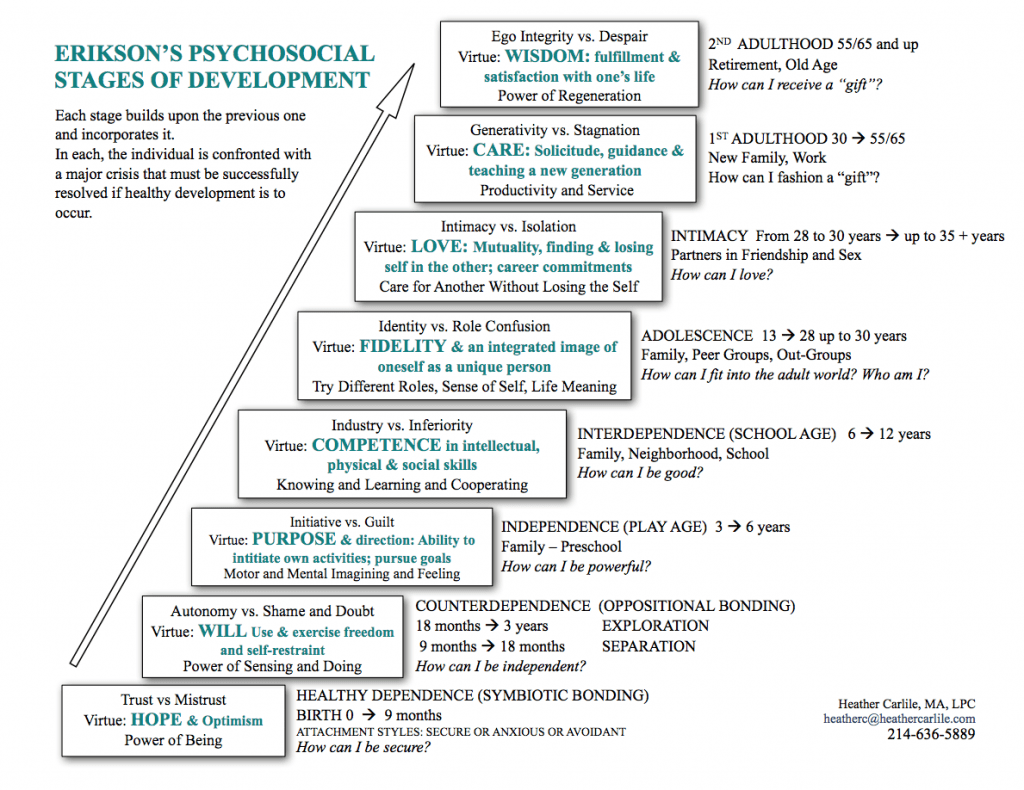Have you ever wondered why toddlers throw tantrums or why teenagers become secretive? These behaviors are often linked to the challenges of growing up. Erik Erikson’s theory of psychosocial development provides a valuable framework for understanding the emotional and social changes people experience throughout their lives. This guide explores Erikson’s eight stages, explaining the specific challenges each stage presents and offering practical tips for navigating them effectively. Whether you’re a parent, educator, or simply interested in human development, this resource offers insights to support healthy growth and build strong relationships.
Erikson’s theory centers on psychosocial crises, which are challenges encountered at each stage of life that significantly influence personality and self-identity. Successfully navigating these challenges leads to positive outcomes, while struggling may result in negative consequences affecting future development. It’s important to view these stages as flexible guidelines rather than rigid categories, acknowledging that individual experiences may vary. Now, let’s explore each stage in detail.
- Core Principle: Erikson’s stages serve as a roadmap for emotional and social development.
- Long-Term Impact: Successfully resolving each stage promotes positive outcomes and resilience.
- Individual Variability: The stages are guidelines, accommodating individual variations in experience.
Delving Into Erikson’s Stages of Psychosocial Development
Erik Erikson’s theory offers a roadmap for understanding the emotional and social milestones from infancy through old age. It isn’t a rigid set of rules, but rather a flexible guide to how our personalities develop and how we address life’s challenges at different ages. Imagine it as a series of stepping stones, representing key stages in our lives. Successfully navigating each stone builds strength and confidence for the next. However, missteps don’t mean failure; they simply indicate a need for extra support to regain balance. Consulting a well-structured Erikson’s stages of development PDF can be incredibly useful for understanding this process and the impact of environmental influences.
The Eight Stages: Navigating Psychosocial Crises Throughout Life
Erikson’s theory outlines eight distinct psychosocial stages, each defined by a unique conflict or challenge. Successfully resolving each conflict typically leads to a healthier personality. Let’s examine each stage more closely, illustrating the concepts with real-world examples. Understanding the importance of successfully resolving the initial stage, trust versus mistrust, influences all subsequent stages of development.
-
Trust vs. Mistrust (Birth to 18 Months): This stage is foundational, babies learn to trust caregivers based on consistent responsiveness. A consistently loving and attentive parent teaches their baby that the world is a safe and predictable place. Conversely, inconsistent care or neglect can lead to mistrust and anxiety. A baby learning to trust is developing a sense of security. This trust extends to believing in themselves and others.
- Action: Consistent and responsive caregiving fosters trust and security in infants.
-
Autonomy vs. Shame and Doubt (2 to 3 Years): Toddlers are driven by a desire for independence. They are discovering their own will and abilities. Potty training exemplifies this stage; success boosts their confidence, while constant criticism or pressure can lead to shame and self-doubt. Encouraging their attempts at self-sufficiency, even if messy, is crucial. It sets the stage for future independence and decision-making skills.
- Action: Supporting independence and self-sufficiency nurtures a toddler’s autonomy and initiative.
-
Initiative vs. Guilt (3 to 5 Years): Preschoolers are brimming with ideas and a desire to try new things. They are becoming more assertive and independent, with pretend play being central to this stage. Supporting their curiosity and initiative helps them develop a sense of purpose. However, excessive criticism or punishment can stifle their drive and instill feelings of guilt. A child wanting to help with dinner preparations, only to be scolded for making a mess, may experience guilt and a diminished desire to take initiative.
- Action: Encourage curiosity, exploration, and responsible risk-taking in preschoolers to cultivate initiative.
-
Industry vs. Inferiority (6 to 11 Years): This stage revolves around mastering new skills and building competence. Children compare themselves to peers academically and socially. Successfully navigating schoolwork, making friends, and participating in hobbies contributes to a sense of accomplishment. However, persistent criticism or repeated failure can foster feelings of inferiority and inadequacy. A child excelling in creative writing but struggling with mathematics might feel inferior if their math difficulties are not addressed with patience and tailored support.
- Action: Provide opportunities for success, skill-building, and recognition to foster competence in school-aged children.
-
Identity vs. Role Confusion (12 to 18 Years): Adolescence is characterized by self-discovery and identity exploration. Teenagers experiment with different roles and beliefs to figure out who they are. Success in this stage involves developing a clear sense of self and future goals. Failure can lead to confusion, uncertainty, and identity crises. They may struggle with defining their values, understanding their place in society, or envisioning their future. Mentorship programs and diverse extracurricular activities can aid in this exploration.
- Action: Allow teenagers to explore their interests, values, and beliefs to discover a unique identity and sense of belonging.
-
Intimacy vs. Isolation (19 to 40 Years): Young adulthood focuses on forming close, intimate relationships – romantic partnerships and deep friendships. The ability to share oneself with another person builds intimacy and security, while difficulties in forming attachments can lead to feelings of isolation. This stage emphasizes the need for both independence and connection. Studies show that individuals with robust social support networks experience enhanced emotional well-being and resilience. Dating apps and social clubs offer environments for connection.
- Action: Foster supportive relationships, communication skills, and emotional vulnerability to support intimacy and social harmony.
-
Generativity vs. Stagnation (40 to 65 Years): Middle-aged adults often seek to contribute something meaningful to the world. This could involve raising a family, mentoring others, engaging in community service, or making a significant impact through their work. Feeling a sense of purpose and accomplishment brings satisfaction, while stagnation can lead to feelings of emptiness and unfulfillment. Contributing to society fosters a sense of worth and legacy. Volunteering at local charities or mentoring young professionals can provide avenues for generativity.
- Action: Encourage involvement in meaningful activities, community engagement, and personal growth to promote generativity and fulfillment in midlife.
-
Integrity vs. Despair (65 Years and Older): The final stage involves reflecting on life’s journey. Did you lead a life that feels meaningful and fulfilling? A sense of integrity provides peace and acceptance. Conversely, regret and unfulfilled desires may fuel despair. This stage centers on finding meaning in one’s experiences. Reminiscing about positive life events can significantly improve older adults’ well-being and self-esteem. Retirement communities and senior centers often facilitate these reflective experiences.
- Action: Encourage reflection on life experiences, storytelling, and finding meaning to foster integrity in later life.
Applying Erikson’s Theory: Benefits for Parents, Educators, and Therapists
Erikson’s theory provides valuable insights for parents, educators, and therapists. Understanding these stages of social and emotional development aids in creating positive outcomes for children and adults.
| Stakeholder Group | Practical Application |
|---|---|
| Parents | Understanding their child’s developmental needs at each stage and adapting their parenting style accordingly. Encouraging exploration during the identity stage, providing comfort during trust vs mistrust, and fostering independence during autonomy vs shame and doubt. |
| Educators | Designing age-appropriate learning experiences that challenge and support students’ psychosocial development. Creating a supportive classroom environment where students feel safe to take risks enhances their feelings of industry and initiative. |
| Therapists | Utilizing the framework to understand the roots of emotional and behavioral challenges and tailoring treatment plans accordingly. Identifying the stage where struggles originated is key to addressing maladaptive patterns. |
Important Note: While Erikson’s stages offer a valuable framework, they should not be regarded as rigid or inflexible. Individual experiences, cultural contexts, and socioeconomic factors significantly influence the journey through these stages. The theory provides guidance, not absolute rules.
Expanding Your Knowledge: Further Exploration
Erikson’s theory is a rich and complex subject with ongoing research and evolving perspectives. While an Erikson’s stages of development PDF can provide a solid foundation, further exploration into the nuances of each stage and the influence of diverse cultural and societal elements will provide a more thorough understanding. The theory inspires further investigation and application, fostering a deeper understanding of the connection between personal growth and the social world, applicable for understanding ourselves and others throughout our lives.
Adapting Erikson’s Stages to Diverse Cultural Contexts
Key Takeaways:
- Erikson’s eight stages offer a valuable framework for understanding human development across cultures.
- Successful navigation of these stages is significantly influenced by cultural norms and expectations.
- Applying Erikson’s theory requires a sensitive and nuanced approach to cultural differences.
- Awareness of cultural variations is essential for effective interventions and support.
- Social workers must integrate Erikson’s model with other culturally relevant frameworks for holistic care.
Erikson’s Framework: A Cross-Cultural Perspective
Erik Erikson’s theory outlines eight psychosocial stages, each presenting a unique crisis that requires resolution. These crises shape personality development throughout the lifespan. Successful resolution of each stage contributes to the
- Weight Loss for Men Builds Habits for Lasting Success - October 27, 2025
- How To Lose 50 Pounds In 6 Months The Right Way - October 26, 2025
- Lose 50 Pounds in Six Months Healthily and Realistically - October 25, 2025










